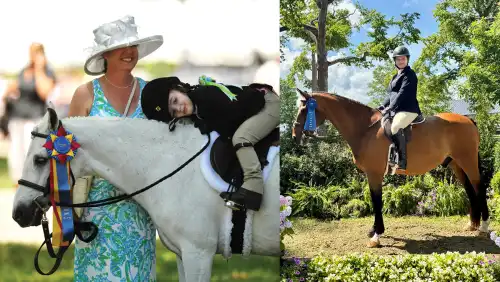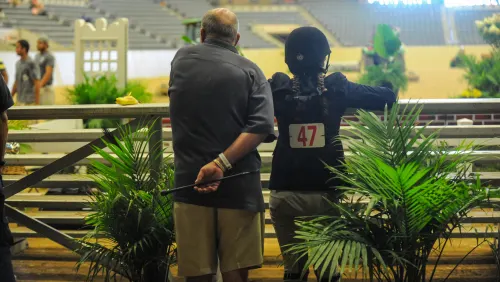Navigating the schooling area at a show can sometimes feel like a perverted game of dodgeball played with large equines. A frenzied warm-up can quickly sabotage a day of showing, so it’s in the best interests of you and your horse to learn how to keep your cool. Grand prix show jumper Callan Solem and top hunter rider Liza Towell Boyd shared some of their schooling area strategies for success.
“I really feel that it’s the rider’s responsibility to make it as easy emotionally and physically for the horse as you possibly can,” said Solem. “Some horses deal with it better than others. But a lot of that anxiety goes away when they trust their rider; when they believe you will keep them safe.”
Do Your Homework Before The Test
Solem and Boyd stressed the importance of a “less is more” approach in the schooling area right before you show.
The time to get your horse relaxed, listening and in the groove isn’t 10 minutes before you show, but in a ride earlier in the day. Frequently, the early-morning hours of a horse show—before the classes start—are a quieter environment, and it’s easier to find space to work your horse and concentrate.
“It is nice for them to get the bulk of their exercising done in as quiet an area as you can,” said Solem. “Really take the time to figure out how to be able to have your horse arrive at the schooling area ready to just limber up and then go. They’re not going to be learning anything in the schooling area; it’s just a time to get them settled and focused and listening to your direction as much as you can.
“If you do that well, then when it’s time to show, you’ve narrowed it down to only needing to do minimal warm-up. If I can, I like to jump just a friendly gymnastic in the morning, something nice and simple just to get their shoulders and backs loosened up. Then you can just jump a few jumps before your class. It doesn’t behoove you to jam 15 jumps into the span of three horses’ trips to be ready to go in the ring. You should have most of your work done, so you only need minimal amount out of that warm-up because you’ve set the stage for it to go well,” she continued.
Be Aware And Polite
ADVERTISEMENT
Riding your horse through a hectic schooling area is very much like driving a car on a busy road, only with fewer rules! Don’t just put your head down and stare straight ahead. Keep your eyes up and be constantly aware of the other horses. Keeping tabs on where other people are can help you avoid a near-collision.
“You have to communicate with everyone there; everyone’s after the same goal, so talk to people and try to make sure you’re all working together,” said Boyd.
If you’re on the approach to a jump, and another rider seems to be intending to cross your path, alert them nicely. “You can say, ‘Heads up,’ but if it’s going to be dicey, do a circle. You just can’t get frustrated,” said Boyd. “Be courteous and polite; I think that goes a long way.”
The general rule for passing oncoming traffic is left-hand-to-left-hand, just like while driving a car. Not everyone observes this custom, but it’s a good policy to keep. And if there’s any question about where you’re headed, speak up. Call out “outside” or “inside” to make sure an oncoming rider knows where you’d like to go.
Keep It Simple
Even though the butterflies in your stomach might be having a party as you warm up for your class, try to keep everything consistent in your riding. Keeping your cool is the key to preserving your horse’s peace of mind.
“Horses are amazing; they’ll do anything in the world for you, but they also know when you’re panicking,” said Solem. “If you want your horse relaxed and focused, you need to have a relaxed and focused mentality for them to follow. There’s always something, whether it’s a busy schooling area, or there’s an umbrella by the fence—there’s always a reason to freak out if you want to find one, but it doesn’t get you very far.”
Making your aids clear and basic will help your horse focus on what you’re asking, rather than the craziness around him. “So keep it as simple as you can. Don’t overwhelm your horse with 100 instructions. When the riding starts to feel unfamiliar in those situations, it makes the horse more upset,” said Solem.
ADVERTISEMENT
And remember that the schooling area is not the place to train a horse or teach it something new; your warm-up before a class should just be putting the polish on what you already know.
Sometimes, discretion is the better part of valor. Don’t be afraid to take a time-out if your horse needs to collect his thoughts. “Rather than getting them all flustered and trying to jump a lot, just jump a few and go in the ring. I’ve had some hot horses that I’ll jump one jump, then let them go fall asleep at the in-gate for a while,” said Boyd.
Prepare Your Horse
If you have a green horse who isn’t used to crowds, a busy schooling area can be intimidating. Boyd recommended simulating the environment when you’re at home to help prepare a green horse for the challenge.
“A lot of times we’ll just sit on them while we’re teaching lessons,” Boyd said. “We’ll have other riders trot circles around us and come closer to get them exposed to as much as we can.”
You can also take your horse to smaller schooling shows and familiarize him with the hustle and bustle of a schooling area when there’s no pressure to get to the ring and perform. Just take care to stay out of the way of those who are actually showing.
Solem believes that most of a horse’s insecurities in the schooling area can be fixed by making sure the horse is definitively in front of your leg. “I really do think that when horses get worried in traffic and wheel around when horses are coming toward them, it really is that they’re just behind your leg,” she said.
“You can address that at home quietly. You can make that go away without practicing it in traffic, by making sure you’ve kept them in front of you leg in a spooky situation, whether it’s going by a trash can with the bag blowing in the wind, or whatever it is. If they’re in front of your leg, usually, it’s all fine.
“It’s amazing to me when people complain about a trafficky schooling area because they used horses in war. Horses will literally gallop through battle for you if you train them correctly and tell them to,” Solem continued. “Horses are brave; that’s what’s so special about them. But riders have to take responsibility for having the right mentality to inspire them.”















